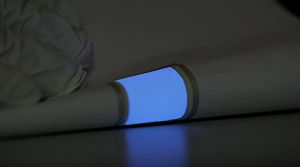Conventional electroluminescent (EL) foils can be bent up to a certain degree only and can be applied easily onto flat surfaces. The new process developed by Karlsruhe Institute of Technology (KIT) in cooperation with the company of Franz Binder GmbH & Co. now allows for the direct printing of electroluminescent layers onto three-dimensional components. Such EL components might be used to enhance safety in buildings in case of power failures. Other potential applications are displays and watches or the creative design of rooms. The development project was funded with EUR 125,000 by the Deutsche Bundesstiftung Umwelt (German Foundation for the Environment).
“By means of the innovative production process we developed together with our industry partner, any type of three-dimensional object can be provided with electroluminescent coatings at low costs,” Dr.-Ing. Rainer Kling of the Light Technology Institute of KIT says. Usually, the luminescent material is located between two plastic layers in EL carrier foils. By means of the new printing process, however, the electroluminescent layers are directly printed onto the object without any intermediate carrier. In this way, convex and concave surfaces of various materials, such as paper or plastic, can be made glow.
The different components of the coating, including the electroluminescent and the electrically conductive materials, are applied by a novel pad printing process. The pad printing machine is equipped with an elastic rubber pad that is easily deformable and, hence, excellently suited for the coating of curved surfaces.
“In this way, it is possible to provide surfaces and even spheres with homogeneous coatings at low costs,” says engineer Elodie Chardin, who works on this research project. “Homogeneity of the coating of about one tenth of a millimeter in thickness was one of the challenges of this project,” says the executive engineer of the industry partner, Elisabeth Warsitz. The process requires a few production steps only and, hence, is characterized by a low consumption of resources. By using various luminescent substances, various colors may be applied to the same surface.
The research and development project of KIT in cooperation with the Binder Connector Group, headquartered in the German town of Neckarsulm, took about two years and was funded with EUR 125,000 by the Deutsche Bundesstiftung Umwelt (German Foundation for the Environment). The foundation funds projects for the protection of the environment, with one project partner being a small or medium-sized company. After the successful development of the prototype printing process for electroluminescent layers, the Light Technology Institute of the KIT Department of Electrical Engineering and Information Technology plans further research projects for the optimization of this innovative production process of electroluminescent coatings.
Video on the production of glowing paper:
https://www.youtube.com/watch?v=h8xQfvOWBuA
Being “The Research University in the Helmholtz Association”, KIT creates and imparts knowledge for the society and the environment. It is the objective to make significant contributions to the global challenges in the fields of energy, mobility, and information. For this, about 10,000 employees cooperate in a broad range of disciplines in natural sciences, engineering sciences, economics, and the humanities and social sciences. KIT prepares its 22,800 students for responsible tasks in society, industry, and science by offering research-based study programs. Innovation efforts at KIT build a bridge between important scientific findings and their application for the benefit of society, economic prosperity, and the preservation of our natural basis of life. KIT is one of the German universities of excellence.

